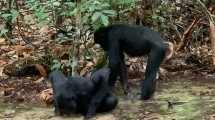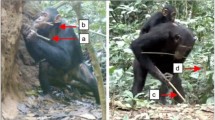Abstract
Use of leaves or sticks for drinking water has only rarely been observed during long-term study of wild chimpanzees (Pan troglodytes schweinfurthii) at Mahale. Recently, however, we observed 42 episodes of tool-use for drinking water (73 tools and two cases of using “tool-sets”) between 1999 and 2004. Interestingly, all of the performers were immature chimpanzees aged from 2 to 10 years. Immature chimpanzees sometimes observed the tool-using performance of others and subsequently reproduced the behavior, while adults usually paid no attention to the performance. This tool-use did not seem to occur out of necessity: (1) chimpanzees often used tools along streams where they could drink water without tools, (2) they used tools for drinking water from tree holes during the wet season when they could easily obtain water from many streams, and (3) the tool-using performance sometimes contained playful aspects. Between-site comparisons revealed that chimpanzees at drier habitats used tools for drinking water more frequently and in a more “conventional” manner. However, some variations could not be explained by ecological conditions. Such variations and the increase in this tool-use in recent years at Mahale strongly suggest that social learning plays an important role in the process of acquiring the behavior. We should note here that such behaviors that lack obvious benefits or necessity can be prevalent in a group.


Similar content being viewed by others
References
Assersohn C, Whiten A, Kiwede ZT, Tinka J, Karamagi J (2004) Use of leaves to inspect ectoparasites in wild chimpanzees: a third cultural variant? Primates 45:255–258
Biro D, Inoue-Nakamura N, Tonooka R, Yamakoshi G, Sousa C, Matsuzawa T (2003) Cultural innovation and transmission of tool use in wild chimpanzees: evidence from field experiments. Anim Cogn 6:213–223
Boesch C (1991) Handedness in wild chimpanzees. Int J Primatol 12:541–558
Boesch C, Boesch-Achermann H (2000) The chimpanzees of the Taï forest: behavioural ecology and evolution. Oxford University Press, Oxford
Clark Arcadi A, Robert D, Mugurusi F (2004) A comparison of buttress drumming by male chimpanzees from two populations. Primates 45:135–139
Goodall J (1964) Tool-using and aimed throwing in a community of free-living chimpanzees. Nature 201:1264–1266
Goodall J (1986) The chimpanzees of Gombe. Harvard University Press, Cambridge
Hayaki H (1985) Social play of juvenile and adolescent chimpanzees in the Mahale Mountains National Park, Tanzania. Primates 26:343–360
Hayashi M, Matsuzawa T (2003) Cognitive development in object manipulation by infant chimpanzees. Anim Cogn 6:225–233
Hiraiwa-Hasegawa M (1990) Maternal investment before weaning. In: Nishida T (ed) The chimpanzees of the Mahale Mountains: sexual and life history strategies. University of Tokyo Press, Tokyo, pp 257–266
Hiraiwa-Hasegawa M, Hasegawa T, Nishida T (1984) Demographic study of a large-sized unit-group of chimpanzees in the Mahale Mountains, Tanzania: a preliminary report. Primates 25:401–413
Huffman MA (1984) Stone-play of Macaca fuscata in Arashiyama B troop: transmission of a non-adaptive behavior. J Hum Evol 13:725–735
Humle T, Matsuzawa T (2002) Ant-dipping among the chimpanzees of Bossou, Guinea, and some comparisons with other sites. Am J Primatol 58:133–148
Hunt KD, McGrew WC (2002) Chimpanzees in the dry habitats of Assirik, Senegal and Semliki Wildlife Reserve, Uganda. In: Boesch C, Hohmann G, Marchant LF (eds) Behavioural diversity in chimpanzees and bonobos. Cambridge University Press, Cambridge, pp 35–51
Itoh N (2002) Food in the forests: chimpanzee food density and space distribution. In: Nishida T, Uehara S, Kawanaka K (eds) The Mahale chimpanzees: thirty-seven years of “panthropology.” Kyoto University Press, Kyoto, pp 77–100 (in Japanese)
Kitahara-Frisch J, Norikoshi K (1982) Spontaneous sponge-making in captive chimpanzees. J Hum Evol 11:41–47
Lanjouw A (2002) Behavioural adaptations to water scarcity in Tongo chimpanzees. In: Boesch C, Hohmann G, Marchant LF (eds) Behavioural diversity in chimpanzees and bonobos. Cambridge University Press, Cambridge, pp 52–60
van Lawick-Goodall J (1968) The behaviour of free-living chimpanzees in the Gombe Stream Reserve. Anim Behav Monogr 1:161–311
Matsusaka T (2004) When does play panting occur during social play in wild chimpanzees? Primates 45:221–229
Matsusaka T, Kutsukake N (2002) Use of leaf-sponge and leaf-spoon by juvenile chimpanzees at Mahale. Pan Africa News 9(1):6–9http://mahale.web.infoseek.co.jp/PAN/9_1/9(1)-04.html
McGrew WC (1977) Socialization and object manipulation of wild chimpanzees. In: Chevalier-Skolnikoff S, Poirier FE (eds) Primate bio-social development. Garland Publishing, New York, pp 261–288
McGrew WC (1992) Chimpanzee material culture. (Translated into Japanese by Nishida T, Adachi K, Suzuki S 1996 Nakayama-Shoten, Tokyo)
McGrew WC, Marchant LF, Nishida T (eds) (1996) Great ape societies. Cambridge University Press, Cambridge
Mitani JC, Hasegawa T, Gros-Louis J, Marler P, Byrne R (1992) Dialects in wild chimpanzees? Am J Primatol 27:233–243
Morimura N (2003) A note on enrichment for spontaneous tool use by chimpanzees (Pan troglodytes). Appl Anim Behav Sci 82:241–247
Nakamura M (2002) Grooming-hand-clasp in Mahale M group chimpanzees: implications for culture in social behaviours. In: Boesch C, Hohmann G, Marchant LF (eds) Behavioural diversity in chimpanzees and bonobos. Cambridge University Press, Cambridge, pp 71–83
Nakamura M, McGrew WC, Marchant LF, Nishida T (2000) Social scratch: another custom in wild chimpanzees? Primates 41:237–248
Nakamura M, Uehara S (2004) Proximate factors of different types of grooming hand-clasp in Mahale chimpanzees: implications for chimpanzee social customs. Curr Anthropol 45:108–114
Nishida T (1980) Local differences in responses to water among wild chimpanzees. Folia Primatol 33:189–209
Nishida T (1988) Development of social grooming between mother and offspring in wild chimpanzees. Folia Primatol 50:109–123
Nishida T (1990) A quarter century of research in the Mahale Mountains: an overview. In: Nishida T (ed) The chimpanzees of the Mahale Mountains: sexual and life history strategies. University of Tokyo Press, Tokyo, pp 3–35
Nishida T (2003) Individuality and flexibility of cultural behavior patterns in chimpanzees. In: de Waal FBM, Tyack PL (eds) Animal social complexity. Harvard University Press, Cambridge, pp 392–417
Nishida T, Corp N, Hamai M, Hasegawa T, Hiraiwa-Hasegawa M, Hosaka K, Hunt KD, Itoh N, Kawanaka K, Matsumoto-Oda A, Mitani JC, Nakamura M, Norikoshi K, Sakamaki T, Turner L, Uehara S, Zamma K (2003) Demography, female life history, and reproductive profiles among the chimpanzees of Mahale. Am J Primatol 59:99–121
Nishida T, Hiraiwa M (1982) Natural history of a tool-using behavior by wild chimpanzees in feeding upon wood-boring ants. J Hum Evol 11:73–99
Nishida T, Hiraiwa-Hasegawa M, Hasegawa T, Takahata Y (1985) Group extinction and female transfer in wild chimpanzees in the Mahale National Park, Tanzania. Z Tierpsychol 67:284–301
Nishida T, Mitani JC, Watts DP (2004) Variable grooming behaviours in wild chimpanzees. Folia Primatol 75:31–36
Nishida T, Wallauer W (2003) Leaf-pile pulling: an unusual play pattern in wild chimpanzees. Am J Primatol 60:167–173
Nishida T, Wrangham RW, Goodall J, Uehara S (1983) Local differences in plant-feeding habits of chimpanzees between the Mahale Mountains and Gombe National Park, Tanzania. J Hum Evol 12:467–480
Nishie H (2002) The proximate factors of stone handling behaviour of Japanese macaques (Macaca fuscata) in Arashiyama E troop. Primate Res 18:225–232 (in Japanese with English summary)
Phillips KA (1998) Tool use in wild capuchin monkeys (Cebus albifrons trinitatis). Am J Primatol 46:259–261
van Schaik CP, Ancrenaz M, Borgen G, Galdikas B, Knott CD, Singleton I, Suzuki A, Utami SS, Merrill M (2003) Orangutan cultures and the evolution of material culture. Science 299:102–105
Sugiyama Y (1989) Description of some characteristic behaviors and discussion on their propagation process among chimpanzees of Bossou, Guinea. In: Sugiyama Y (ed) Behavioral studies of wild chimpanzees at Bossou, Guinea. KUPRI, Inuyama, pp 43–76
Sugiyama Y (1995) Drinking tools of wild chimpanzees at Bossou. Am J Primatol 37:263–269
Sugiyama Y (1997) Social tradition and the use of tool-composites by wild chimpanzees. Evol Anthropol 6:23–27
Suzuki S, Kuroda S, Nishihara T (1995) Tool-set for termite-fishing by chimpanzees in the Ndoki Forest, Congo. Behaviour 132:219–235
Takasaki H, Nishida T, Uehara S, Norikoshi K, Kawanaka K, Takahata Y, Hiraiwa-Hasegawa M, Hasegawa T, Hayaki H, Masui K, Huffman MA (1990) Summary of meteorological data at Mahale research camps, 1973–1988. In: Nishida T (ed) The chimpanzees of the Mahale Mountains: sexual and life history strategies. University of Tokyo Press, Tokyo, pp 291–300
Takeshita H, van Hooff JARAM (1996) Tool use by chimpanzees (Pan troglodytes) of the Arnhem Zoo community. Jpn Psychol Res 38:163–173
Tonooka R (2001) Leaf-folding behavior for drinking water by wild chimpanzees (Pan troglodytes verus) at Bossou, Guinea. Anim Cogn 4:325–334
Tonooka R, Tomonaga M, Matsuzawa T (1997) Acquisition and transmission of tool making and use for drinking juice in a group of captive chimpanzees (Pan troglodytes). Jpn Psychol Res 39:253–265
Turner LA (2000) Vegetation and chimpanzee ranging in the Mahale Mountains National Park, Tanzania. PhD thesis, Kyoto University, Kyoto
Whiten A, Goodall J, McGrew WC, Nishida T, Reynolds V, Sugiyama Y, Tutin CEG, Wrangham RW, Boesch C (1999) Cultures in chimpanzees. Nature 399:682–685
Whiten A, Goodall J, McGrew WC, Nishida T, Reynolds V, Sugiyama Y, Tutin CEG, Wrangham RW, Boesch C (2001) Charting cultural variation in chimpanzees. Behaviour 138:1481–1516
Wrangham RW, Nishida T (1983) Aspilia spp. leaves: a puzzle in the feeding behavior of wild chimpanzees. Primates 24:276–282
Wrangham RW, de Waal FBM, McGrew WC (1994) The challenge of behavioral diversity. In: Wrangham RW, McGrew WC, de Waal FBM, Heltne PG (eds) Chimpanzee cultures. Harvard University Press, Cambridge, pp 1–18
Yamakoshi G (1998) Dietary responses to fruit scarcity of wild chimpanzees at Bossou, Guinea: possible implications for ecological importance of tool use. Am J Phys Anthropol 106:283–295
Yamakoshi G, Myowa-Yamakoshi M 2004 New observations of ant-dipping techniques in wild chimpanzees at Bossou, Guinea. Primates 45:25–32
Acknowledgments
We thank the Tanzania Commission for Science and Technology, Tanzania Wildlife Research Institute, Mahale Mountains Wildlife Research Centre, and Tanzania National Parks for permitting us to do this research at Mahale and for their support while we were in Tanzania; L.F. Marchant, W.C. McGrew, H. Takasaki, T. Tsukahara, and M. Bunengwa for providing information about the previous observations of the studied tool-use; T. Humle, K.D. Hunt, and an anonymous referee, and the associate editor, W.C. McGrew, for useful comments and suggestions that have improved the manuscript; J. Yamagiwa, Y. Takenoshita, and other members of the Laboratory of Human Evolution Studies, Kyoto University for their useful comments and support. This study was financially supported by MEXT Grant-in-Aid for Scientific Research (A1) (#12375003 and #16255007 to T.N.), MEXT COE Research (#10CE2005 to Osamu Takenaka), MEXT 21st century COE Research Kyoto University (#A14), and JSPS Research Fellowships (to N.K.).
Author information
Authors and Affiliations
Corresponding author
About this article
Cite this article
Matsusaka, T., Nishie, H., Shimada, M. et al. Tool-use for drinking water by immature chimpanzees of Mahale: prevalence of an unessential behavior. Primates 47, 113–122 (2006). https://doi.org/10.1007/s10329-005-0158-4
Received:
Accepted:
Published:
Issue Date:
DOI: https://doi.org/10.1007/s10329-005-0158-4




